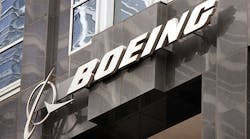Boeing Co. says the potential market for its first all-new passenger jet since the 787 Dreamliner is coming into sharp focus — and it could be huge.
The U.S. planemaker is honing designs for mid-range planes to whisk travelers from New York to London, Sydney to Shanghai, or Dubai to Oslo. The aircraft would fill the gap in its product line between the largest single-aisle 737 and smallest widebody 787, a relatively untapped market where Airbus Group SE is starting to extend its reach.
Boeing estimates that sales could reach between 4,000 and 5,000 middle-of-market jetliners as airlines find new routes for the planes. The U.S. manufacturer would be poised to capitalize, provided it can keep production costs in check and prices reasonable, said Mike Delaney, general manager of airplane development. He used the term “when,” not “if,” while discussing the prospects for the new aircraft family, which would begin commercial flights next decade.
Recent discussions with 36 airline customers have given Delaney confidence that Boeing is on the verge of a breakthrough after years spent seeking a replacement for its out-of-production 757. Mike Sinnett, who heads product development for the company’s commercial planes, has delved into the prices airlines would be willing to pay, and performance they’d expect, for jets that seat between 200 and 270 people with the range to fly about 5,000 nautical miles.
“It is not easy, it is not impossible. We are not there yet,” Delaney told reporters in a briefing last month ahead of the Farnborough International Airshow. “But in the last six months Mike’s team has closed the gap pretty good.”
Boeing’s board must still green-light the effort, and the business case is challenging. Analysts have pegged demand more conservatively, at around 1,500 planes, said aerospace consultant Kevin Michaels. Developing a clean-sheet design would cost at least $10 billion, and that’s assuming Boeing avoids the stumbles that delayed the Dreamliner’s 2011 debut by more than three years.
“The economics are going to be everything because of the entry costs,” said Michaels, managing director of Aerodynamic Advisory in Ann Arbor, Michigan. “I think the likely scenario is maybe they get board approval to begin selling it later this year.”
Airbus has gained sales by pitching its A320neo as the 757’s heir. The European planemaker’s largest narrowbody has notched 1,125 orders to 222 for Boeing’s rival 737 Max 9, according to data compiled by George Ferguson, senior analyst with Bloomberg Intelligence. But the largest Airbus model can’t be stretched to reach the sweet spot of the market that Boeing envisions, Delaney said.
It’s untapped because of the difficulty in building the plane with some of the structural complexity of a twin-aisle model but at costs that are closer to those of a narrowbody, said Randy Tinseth, Boeing’s vice president for marketing. Manufacturing improvements, including stepped-up efficiency in 787 production, are boosting the company’s confidence in taking on a new model.
“Technology has advanced both in terms of what we can do, how we build the airplane,” he said. “We’ve advanced the production systems as well. That’s why it’s very interesting.”
The proposed airplane would be built at a tempo that falls somewhere between that of the 737, which roll out of Boeing’s Seattle-area factory at a pace of two a day, and the 787’s monthly output of 12 jets, Tinseth said.
Boeing hasn’t decided if the new plane’s frame would be metallic or made from spun-carbon fiber like the 787, or if it would have one or two aisles. Michaels thinks a single aisle wide enough to fit two people is also a possibility. The jetliner’s presumably all-new fuselage, cockpit, electric systems and production could all be battle-tested for the plane that will someday replace the 737, Boeing’s largest source of profit, he said.
The planemaker is in discussions with the three largest engine-makers for a new turbine to power the aircraft as it seeks performance gains of at least 20% compared with the 757 and 767 jetliners Boeing introduced to serve the middle of the market in the 1980s.
“You’d have to see tremendous gains in efficiency and cost,” Tinseth said.
By Julie Johnsson




